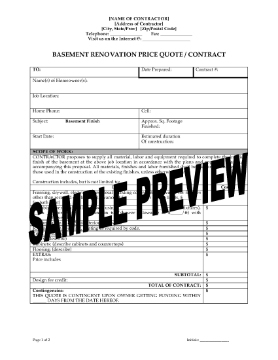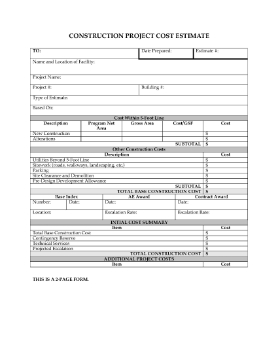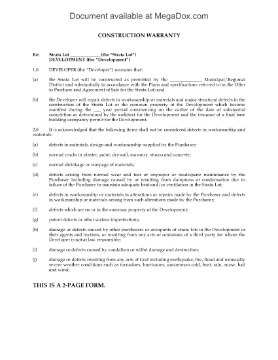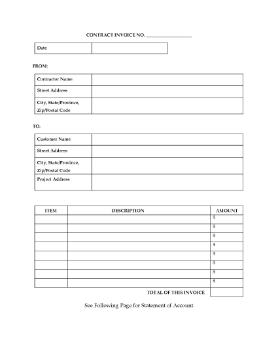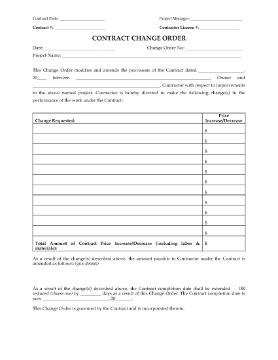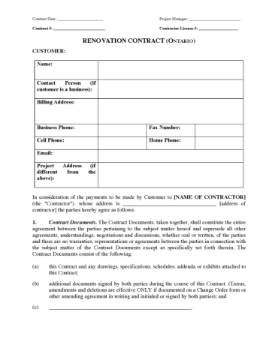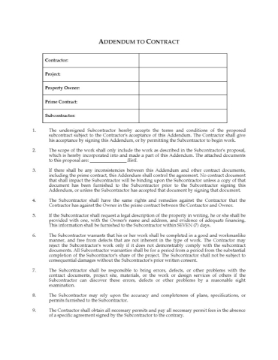Contract Change Order
Prepare a Contract Change Order for changes under a construction or renovation contract with this easy-to-use template form.
- The Change Order form must be signed by both the owner and the contractor, and the owner may require the contractor's surety (if any) to approve the changes as well.
- The changes can include additions, amendments or deletions to the scope of the work, materials, extras, etc., and corresponding adjustments to the contract price.
- The completion date can also be amended to accommodate the changes.
- The Change Order form can be used by general contractors and subtrades alike.
- This is a generic form that can be used anywhere.
Basement Renovation Price Quote and Contract
Write up a price quote for a basement renovation with this template form, which becomes a binding contract when signed by both parties.
- Fully editable so you can customize it for your business.
- Includes scope of work, exclusions, draw dates, and other terms and conditions.
- The template can be firstly as a price quotation, and when agreed to in writing by both parties, it becomes the renovation contract.
- Buy, download and use it as often as you like.
- This Basement Renovation Price Quote and Contract form is available in Microsoft Word format.
Contractor Invoice and Account Statement
Prepare your own contractor invoices for work on residential or commercial properties with this easy-to-use Contractor Invoice and Account Statement form.
- The form includes a customer account statement showing:
- the original contract price,
- additional amounts under any change orders,
- records of deposits and installment payments already made by the customer.
- This form is a digital template that you can customize for your business and use again and again.
Ontario Renovation Contract
Ontario contractors, write up a Renovation Contract for a home owner with this easy-to-use template form.
Responsibilities of the Parties to the Contract
The contractor agrees to provide all required materials, labour and equipment necessary to complete the renovation. The home owner is responsible for arranging utilities, toilets, parking and access to the work site.
Key Features of Agreement
The contract template includes standard provisions, such as:
- Contract Price. Payment of the contract price, less required holdback under the Ontario Construction Lien Act, will be made in several payments, with the balance due on completion.
- Change Orders. A signed change order is required for any alterations to the work specified.
- Site Safety. The contractor is responsible for cleanup and for job site safety.
Contractor Warranty
The contractor provides a 1-year warranty of the materials and workmanship and agrees to correct any defects of which it is notified in writing during the warranty period.
Insurance and Compliance Matters
The contractor is responsible for maintaining adequate insurance, and for complying with the requirements of the Workers Compensation Act.
Format and Jurisdiction
The Renovation Contract template is available in MS Word format and is fully customizable. Once purchased, you can use it as often as you require. The document is intended to be used only in the Province of Ontario, Canada.
Subcontractor Addendum to Contract
Purpose of the Addendum
This Subcontractor Addendum to Contract is required for all subtrades participating in a construction project. Each subcontractor involved must sign this document to confirm their acceptance of the terms outlined herein.
Acceptance of Terms
By signing the Addendum, the subcontractor acknowledges and agrees to the terms and conditions set forth in the primary contractor's Subcontract. This acceptance is conditional upon the contractor also agreeing to the provisions of this Addendum.
Prevailing Document
If there are any discrepancies or conflicts between this Addendum and other contract documents, the terms specified in this Addendum shall take precedence and will govern the agreement.
Rights of the Subcontractor
The subcontractor is entitled to the same rights against the contractor as the contractor has against the property owner. This ensures a consistent and fair approach to all parties involved in the project.
Contractor Responsibilities
Unless otherwise agreed to in writing by the subcontractor, the contractor is responsible for securing all necessary permits and for providing all required site facilities and utilities needed for the project.
Compensation for Schedule Changes
Should there be a change in the project schedule, the subcontractor is entitled to reimbursement for any extra costs incurred as a result of such changes.
Form Availability
This document is a generic form and is not specific to any country. It is provided in Microsoft Word format for convenience.

